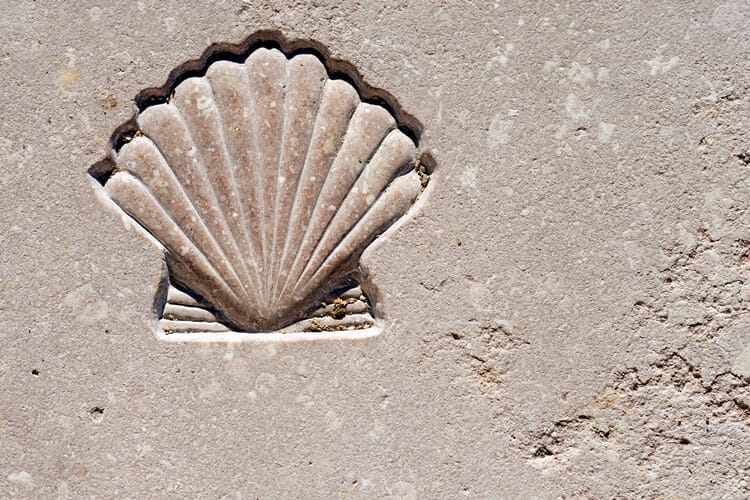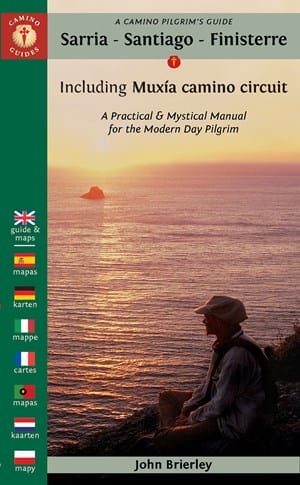Pilgrimage: An Inner and Outer Journey

In this excerpt from A Camino Pilgrim’s Guide: Sarria – Santiago- Finisterre, A Practical and Mystical Manual for the Modern Day Pilgrim the author describes the beauty of the inner and outer journey the pilgrim is about to undertake. In the second section we have excerpted a small piece from the guide to demonstrate how John Brierley has formatted the guide to be a source of wisdom and insight to the traveler on their pilgrimage.
by John Brierley
Pilgrimage and the Camino
All of us travel two paths simultaneously; the outer path along which we haul our body and the inner pathway of soul. We need to be mindful of both and take time to prepare ourselves accordingly. The traditional way of the pilgrim is to travel alone, by foot, carrying all the material possessions we might need for the journey ahead.
This provides the first lesson for the pilgrim – to leave behind all that is superfluous and to travel with only the barest necessities. Preparation for the inner path is similar – we start by letting go of psychic waste accumulated over the years such as resentments, prejudices and outmoded belief systems. Walking with an open mind and open heart allows us to assimilate the lessons to be found along this ancient Path of Enquiry.
We have been asleep a long time. Despite the chaotic world around us, or perhaps because of it, something is stirring us to awaken from our collective amnesia. A sign of this awakening is the number of people drawn to walk the caminos. The hectic pace of modern life, experienced not only in our work but also our family and social lives, spins us ever outwards away from our center. We have allowed ourselves to be thrown onto the surface of our lives – mistaking busy-ness for aliveness, but this superficial existence is inherently unsatisfying.
Pilgrimage offers us an opportunity to slow down and allow some spaciousness into our lives. In this quieter space we can reflect on the deeper significance of our lives and the reasons why we came here. The camino encourages us to ask the perennial question – Who am I? And, crucially, it provides time for answers to be understood and integrated. So don’t rush the camino – take the time it takes because it may well prove a pivotal turning point in your life.

Whichever route we take, our ultimate Destination is assured. The only choice we have is how long it takes us to arrive buen camino.
A synopsis of the history, legends and myths surrounding this fascinating corner at the ‘End of the World’ Finis Terra are included as a backdrop for those interested in their exploration. However, it is their symbolism and the mystical experience to which they point that really matters. Literalism can be a hindrance to a deeper understanding of our lives and our place in the Cosmos. The question is not whether the earthly remains of St. James lie buried in Santiago nor whether Jesus travelled to Finisterre to meet the Druidic masters there – what really matters is whether we can absorb and live out the truth of their core teaching of unconditional love and forgiveness. That is the real task of the true initiate on the spiritual path through this earthly life.
For the majority of pilgrims commencing their journey in Sarria, Santiago is their final destination and they simply aren’t aware of – or haven’t thought about continuing to Finisterre or Mux.a. Others are caught within a tightening schedule requiring an early return home. Some squeeze in a visit by bus but this is no substitute for walking the path which remains one of the most significant of the many camino itineraries. The paths to Finisterre and Mux.a provide an opportunity to integrate our camino experiences before we find ourselves back home… in the fast lane.
In the event that you have already walked to Santiago from Sarria or along one of the myriad routes that converge on this fabled city, you will doubtless be lean and traveling light. Your experiences will stand you well for the journey ahead. Finisterre will challenge but not disappoint. While the bones of the great Saint may lie in Santiago, his spirit flourishes along the Royal Way Camino Real and provides the inspiration and energy to keep on going. Finisterre may prove a humbling experience after the relative glamour of Santiago. If, on the other hand, you are setting off from Santiago on this circuit as a ‘novice’ pilgrim you may wish to check out advice on preparation.
Pilgrimage is experienced on many different levels. At one end is the physical challenge of walking a long distance route in the minimum time with a group of friends. How deep we choose to make the experience is, of course, up to us but perhaps now is an opportunity to experience pilgrimage at a pace that allows for the inner alchemy of introspection. The extended periods of silence will allow time for reflection and to integrate insights leading to change and growth. It is in the silence that we will most likely encounter our Self and that may prove a pivotal turning point.
While there is a plethora of guidebooks on the routes to Santiago there is a dearth of information on the path to Finisterre and Mux.a. Perhaps it is Finisterre’s connection with its pagan past that has acted as a deterrent. This mysterious headland marked the fault line between a Christian point of reference to the east and a pagan orientation to the west. The rising sun over Monte Pindo flooded through the entrance door to the Christian hermitage of San Guillerme but its setting over the western horizon to the Land of Eternal Youth Tir-na-n.g was watched over by the pagan Altar to the SunAra Solis. In the medieval period the focus within Spain was narrowed on Santiago de Compostela but to the wider world that focus had always been westward. That is why references to Finisterre come to us from foreign travellers and historians, from Ptolemy of Egypt at the dawn of the Christian era to George Borrow from England in the 18th century.
Whatever the reason for its relative obscurity, the fact remains that only a small band of pilgrims who make it to Santiago choose to walk on to the coast. But the popularity of this route is on the increase boosted not only by those drawn to walk to Finisterre but by those inspired to walk back to Santiago. Finisterre and Mux.a now form starting points for pilgrims going to Santiago. As the routes are over 100 km it allows the bona fide pilgrim to apply for a compostela.
Finisterre now acts as both destination and starting point. However, if you are drawn to quieter reflection you might be advised to continue along the remote pathway to Mux.a. While it is a thriving fishing port it has a quiet unhurried air and is sufficiently far enough off the beaten track to offer space to integrate the camino experience. It is thus an ideal place in which to write up our diaries and re-orientate and re-dedicate our Selves towards the spiritual reality underpinning our lives before we head back to consensus reality and the hectic ‘realism’ of unconscious materialism and its never-ending dramas.
Whichever path you take – travel well on your pilgrimage, fellow pilgrim, and may you find and become the peace of God that passes all understanding.
Click HERE to Connect with your Daily Horoscope!
About the Author
John Brierley is a former chartered surveyor and the author of A Pilgrim’s Guide to Camino De Santiago, A Pilgrims Guide to Camino Finisterre, and A Pilgrim’s Guide to Camino Portugués.
For more information, or to purchase the book, click the cover or visit: FindhornPress.com
OMTimes Magazine is one of the leading on-line content providers of positivity, wellness and personal empowerment. OMTimes Magazine - Co-Creating a More Conscious Reality










